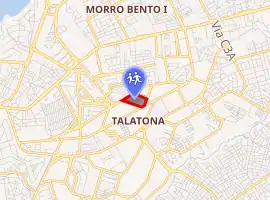Luanda International School
Luanda International School (LIS) is a Preschool–12 private, co-educational international day school in Luanda, Angola. Established in October 1996 by five people interested in the creation of an English-medium international school in Angola, it is supported by oil companies to benefit the families of their employees. The largest interntional schol in Luanda, it is accredited by the New England Association of Schools and Colleges, and the Council of International Schools.
| Luanda International School | |
|---|---|
 | |
| Address | |

| |
Via S6, Bairro de Talatona, Município de Belas | |
| Coordinates | 8.9145°S 13.1901°E |
| Information | |
| Other name | LIS |
| Type | Private international school |
| Established | 1996 |
| Director | Dylan Hughes[1] |
| Staff | 89 |
| Grades | Preschool–12 |
| Gender | Co-educational |
| Enrollment | 686 |
| Language | English |
| Accreditation | International Baccalaureate New England Association of Schools and Colleges Council of International Schools |
| Website | www |
History
Luanda International School opened on 26 October 1996, enrolling 27 students. It was located in the city of Luanda at Rua de Cambambe, 21-23, Bairro de Patrice Lumumba. Founders of the school included Roger Ballard Tremeer, South African Ambassador to Angoloa at that time;[2] Carmen Campbell-Hewitt, the school's founding Principal;[3] and three interested parents: Florbela Lopes, Emilienne Macauley, and Doreen Verster.[2]
Before 2003, the school had moved to its current location at Via S6, Bairro de Talatona, Município de Belas Luanda.[4]
Facilities
In 2003 the school engaged Flansburg architects of Boston to create a master plan for its existing 6.5 hectare (16 acre) campus, as well as for a new 4 hectare (10 acre) site, called the "annex", which would house the lower elementary schol. According to the plan, "upper elementary, secondary school, and central administration are to remain on the existing campus".[5] Michael Specter of The New Yorker described the campus as "beautiful and modern".[6]
LIS is the largest international school in Luanda.[7] The school can expand to include a maximum of 950 students.[5]
Curriculum
LIS is an International Baccalaureate World School (IB) and is authorized to offer three International Baccalaureate programs: Primary Years Program, Middle Years Program and the IB Diploma Program.[1] These programs form the framework for an inquiry-based approach to learning and teaching. For example, in 2017 CNN featured a student who was working on a project to raise awarenes of child trafficking.[8]
The school offers a proactive counselling program.[9]
LIS is accredited by the New England Association of Schools and Colleges,[10] and the Council of International Schools.[11]
Faculty
For the 2019/2020 academic year, there were 89 teaching staff.[11] According to Specter, "The staff is made up largely of foreign teachers, who tend to move every few years among the world's élite international schools."[6]
Enrollment
At the start of the 2019/2020 academic year, enrollment was 689 students. The school's enrollment includes 55 nationalities.[11]
Embassy families and families of employees of BP, Chevron, Exxon/Esso, Halliburton, and Schlumberger are given priority in enrollment.[12] Specter wrote, "Fees, which are almost always paid by oil companies, come to about fifty thousand dollars a year. Some companies even pay when they don't have a student who needs the seat."[2]
Controversy
In 2018, national employees of the school filed a complaint asking "the Ministry of Public Administration, Labor and Social Security ( MAPTSS) carry out a 'very thorough investigation' of that organization..." based on "alleged mistreatment that national workers have been subjected to, as well as the remuneration asymmetries that most benefit foreign workers".[13] The specific complaints included that "foreigners have the right to residence, water and electricity, transportation with a driver, food, health insurance (SOS international), domestic workers, stress subsidies and wage arrears abroad, wages abroad, and annual performance allowance, while national officials are simply entitled to wages, transportation, and food."[13]
References
- "Luanda International School". International Baccalaureate®. Retrieved 24 August 2020.
- "Luanda International School : Africa's List TM". Africa's List : Connecting Africa. 2019. Retrieved 25 August 2020.
- "Business Examiner Victoria". October 2017. p. 21. Retrieved 25 August 2020 – via ISSUU.
- Bingham, Derek (2009). The ECIS International Schools Directory 2009/10. John Catt Educational Ltd. ISBN 978-1-904724-67-4.
- "Luanda International School : Master Plan : Flansburgh Architects". flansburgh.com. 2020. Retrieved 24 August 2020.
- Specter, Michael (25 May 2015). "Extreme City : The severe inequality of the Angolan oil boom". The New Yorker. Retrieved 26 August 2020.
- Stead, Mike; Scafidi, Oscar; Rorison, Sean (5 July 2019). Angola: Bradt Travel Guide. Bradt Travel Guides. p. 43. ISBN 978-1-78477-024-2.
There are international schools in Luanda, the largest being the Luanda International School. The school is well regarded and there is a waitlist for admission. Priority entry is given to the children of employees of the school's sponsoring companies.
- "Inspired to fight slavery". www.cnn.com. Retrieved 15 November 2020.
- Simão, Manuel Miguel Fernandes (2017). Influence of peer counselling on the students' discipline in public secondary schools in dagoretti constituency, Nairobi county, Kenya (PDF). p. 9.
- "Luanda International School". NEASC International Education. 15 May 2020. Retrieved 24 August 2020.
- "Membership Directory - CIS Council of International Schools". www.cois.org. Retrieved 25 August 2020.
- "Here The top 5 Best International Schools in Angola 2018 and their Tuition fees". Top Most 10. 5 June 2018. Retrieved 24 August 2020.
- "Complaints against Luanda International School". Folha 8 Jornal Angolano Independente | Notícias de Angola (in Portuguese). 27 June 2018. Retrieved 24 August 2020.
External links
- Official website
- Luanda International School Exhibition 2004 - 2005 on YouTube (video, 10:29 minutes)
- Text has been adapted from a fact sheet released by the US State Department's Office of Overseas Schools on March 2, 2020,
 This article incorporates public domain material from this U.S government document.
This article incorporates public domain material from this U.S government document.